Effect of Milling Parameters on Mechanical Properties and In Vitro Biocompatibility of Mg-Zn-Co Ternary Alloy
Abstract
:1. Introduction
2. Material and Methods
2.1. Materials
2.2. Alloy Preparation
2.2.1. Sintering
2.2.2. Optical Microscope Analysis
2.2.3. Microstructural Analysis
2.2.4. Phase Identification
2.2.5. Nanohardness Tests
2.2.6. Microindentation
2.2.7. Biocompatibility Analysis
Preparation of Extraction Medium
Cell Culture
MTT Assay
3. Results and Discussion
3.1. Effect of Milling Time on Particle Dispersion of Unsintered Mg-Zn-Co Alloy
3.2. Effect of Ball Size and Milling Time on Morphological Alterations of Unsintered Mg-Zn-Co Alloy
3.3. Effect of Ball Size and Milling Time on Chemical Composition of Sintered Mg-Zn-Co Alloy
3.4. Effect of Milling Time on Formation of Intermetallic Compounds of Mg-Zn-Co Alloy
3.5. Effect of Ball Size and Milling Time on Microhardness of Sintered Mg-Zn-Co Alloy
3.6. Effect of Milling Time on Young’s Modulus of Mg-Zn-Co Alloy
3.7. Effect of Milling Time on Biocompatibility of Mg-Zn-Co Alloy
4. Conclusions
Author Contributions
Funding
Institutional Review Board Statement
Informed Consent Statement
Data Availability Statement
Conflicts of Interest
References
- Gu, X.; Zheng, Y.; Cheng, Y.; Zhong, S.; Xi, T. In Vitro corrosion and biocompatibility of binary magnesium alloys. Biomaterials 2009, 30, 484–498. [Google Scholar] [CrossRef]
- Witte, F.; Kaese, V.; Haferkamp, H.; Switzer, E.; Meyer-Lindenberg, A.; Wirth, C.J.; Windhagen, H. In vivo corrosion of four magnesium alloys and the associated bone response. Biomaterials 2005, 26, 3557–3563. [Google Scholar] [CrossRef] [PubMed]
- Song, G. Control of biodegradation of biocompatable magnesium alloys. Corros. Sci. 2007, 49, 1696–1701. [Google Scholar] [CrossRef]
- Nag, S.; Banerjee, R.; Fraser, H.L. A novel combinatorial approach for understanding microstructural evolution and its relationship to mechanical properties in metallic biomaterials. Acta Biomater. 2007, 3, 369–376. [Google Scholar] [CrossRef] [PubMed]
- Zhang, S.; Zhang, X.; Zhao, C.; Li, J.; Song, Y.; Xie, C.; Tao, H.; Zhang, Y.; He, Y.; Jiang, Y.; et al. Research on an Mg–Zn alloy as a degradable biomaterial. Acta Biomater. 2010, 6, 626–640. [Google Scholar] [CrossRef] [PubMed]
- Zhao, D.; Witte, F.; Lu, F.; Wang, J.; Li, J.; Qin, L. Current status on clinical applications of magnesium-based orthopaedic implants: A review from clinical translational perspective. Biomaterials 2017, 112, 287–302. [Google Scholar] [CrossRef]
- Salleh, E.M.; Zuhailawati, H.; Ramakrishnan, S. Synthesis of biodegradable Mg-Zn alloy by mechanical alloying: Statistical prediction of elastic modulus and mass loss using fractional factorial design. Trans. Nonferrous Met. Soc. China 2018, 28, 687–699. [Google Scholar] [CrossRef]
- Homayun, B.; Afshar, A. Microstructure, mechanical properties, corrosion behavior and cytotoxicity of Mg–Zn–Al–Ca alloys as biodegradable materials. J. Alloys Compd. 2014, 607, 1–10. [Google Scholar] [CrossRef]
- Plum, L.M.; Rink, L.; Haase, H. The essential toxin: Impact of zinc on human health. Int. J. Environ. Res. Public Health 2010, 7, 1342–1365. [Google Scholar] [CrossRef] [Green Version]
- Abbasi, M.; Sajjadi, S.A.; Azadbeh, M. An investigation on the variations occurring during Ni3Al powder formation by mechanical alloying technique. J. Alloys Compd. 2010, 497, 171–175. [Google Scholar] [CrossRef]
- Ilich, J.Z.; Kerstetter, J.E. Nutrition in bone health revisited: A story beyond calcium. J. Am. Coll. Nutr. 2000, 19, 715–737. [Google Scholar] [CrossRef]
- Salahshoor, M.; Guo, Y. Biodegradable orthopedic magnesium-calcium (MgCa) alloys, processing, and corrosion performance. Materials 2012, 5, 135–155. [Google Scholar] [CrossRef] [PubMed] [Green Version]
- Vojtěch, D.; Kubásek, J.; Šerák, J.; Novák, P. Mechanical and corrosion properties of newly developed biodegradable Zn-based alloys for bone fixation. Acta Biomater. 2011, 7, 3515–3522. [Google Scholar] [CrossRef] [PubMed]
- Li, P.; Schille, C.; Schweizer, E.; Rupp, F.; Heiss, A.; Legner, C.; Klotz, U.E.; Geis-Gerstorfer, J.; Scheideler, L. Mechanical characteristics, in vitro degradation, cytotoxicity, and antibacterial evaluation of Zn-4.0 Ag alloy as a biodegradable material. Int. J. Mol. Sci. 2018, 19, 755. [Google Scholar] [CrossRef] [Green Version]
- Ortega, R.; Bresson, C.; Fraysse, A.; Sandre, C.; Devès, G.; Gombert, C.; Tabarant, M.; Bleuet, P.; Seznec, H.; Simionovici, A.; et al. Cobalt distribution in keratinocyte cells indicates nuclear and perinuclear accumulation and interaction with magnesium and zinc homeostasis. Toxicol. Lett. 2009, 188, 26–32. [Google Scholar] [CrossRef]
- Battaglia, V.; Compagnone, A.; Bandino, A.; Bragadin, M.; Rossi, C.A.; Zanetti, F.; Colombatto, S.; Grillo, M.A.; Toninello, A. Cobalt induces oxidative stress in isolated liver mitochondria responsible for permeability transition and intrinsic apoptosis in hepatocyte primary cultures. Int. J. Biochem. Cell Biol. 2009, 41, 586–594. [Google Scholar] [CrossRef]
- Klose, C.; Mroz, G.; Angrisani, G.L.; Kerber, K.; Reimche, W.; Bach, F.W. Casting process and comparison of the properties of adapted load-sensitive magnesium alloys. Prod. Eng. 2013, 7, 35–41. [Google Scholar] [CrossRef]
- Kammer, C.; Aluminium-Zentrale, D. Magnesium Taschenbuch, 1st ed.; Kammer, C., Ed.; Aluminium-Verlag: Düsseldorf, Germany, 2000; Chapter 8; pp. 155–188. [Google Scholar]
- Buchmann, W. Festigkeitseigenschaften. In Magnesium und Seine Legierungen, 2nd ed.; Beck, A., Altwicker, H., Eds.; Springer: Berlin/Heidelberg, Germany, 2001; Chapter 5; pp. 101–271. [Google Scholar]
- Schultze, W. Chemisches Verhalten, Korrosion und Oberflächenschutz. In Magnesium und SeineLegierungen, 2nd ed.; Beck, A., Altwicker, H., Eds.; Springer: Berlin/Heidelberg, Germany, 2001; Chapter 6; pp. 272–312. [Google Scholar]
- Shaw, B.A. Corrosion Resistance of Magnesium Alloys. In ASM Handbook Volume 13A: Corrosion: Fundamentals, Testing, and Protection, 1st ed.; Cramer, S.D., Covino, B.S., Eds.; ASM International: Novelty, OH, USA, 2003; pp. 692–696. [Google Scholar]
- Klose, C.; Demminger, C.; Mroz, G.; Reimche, W.; Bach, F.W.; Maier, H.J.; Kerber, K. Influence of cobalt on the properties of load-sensitive magnesium alloys. Sensors 2013, 13, 106–118. [Google Scholar] [CrossRef]
- Hawke, D.L. Corrosion Behavior. In ASM Specialty Handbook: Magnesium and Magnesium Alloys, 1st ed.; Avedesian, M., Baker, H., Eds.; ASM International: Novelty, OH, USA, 1999; pp. 194–210. [Google Scholar]
- Wetherill, J.P. Magnesium Alloy. U.S. Patent 1,880,614, 4 October 1932. [Google Scholar]
- Benjamin, J.S.; Volin, T.E. The Mechanism of Mechanical Alloying. Metall. Trans. 1974, 5, 1929–1934. [Google Scholar] [CrossRef]
- Suryanarayana, C.; Ivanov, E. Nou® R, Contreras MA, Moore JJ. J. Mater Res. 1999, 14, 377–378. [Google Scholar] [CrossRef]
- Suryanarayana, C. Mechanical alloying: A novel technique to synthesize advanced materials. Research 2019, 2019, 4219812. [Google Scholar] [CrossRef] [PubMed] [Green Version]
- Koch, C.C.; Cavin, O.B.; McKamey, C.G.; Scarbrough, J.O. Preparation of “amorphous” Ni60Nb40 by mechanical alloying. Appl. Phys. Lett. 1983, 43, 1017–1019. [Google Scholar] [CrossRef]
- Francavilla, A.; Zienkiewicz, O.C. A note on numerical computation of elastic contact problems. Int. J. Numer. Methods Eng. 1975, 9, 913–924. [Google Scholar] [CrossRef]
- Sneddon, I.N. The relation between load and penetration in the axisymmetric Boussinesq problem for a punch of arbitrary profile. Int. J. Eng. Sci. 1965, 3, 47–57. [Google Scholar] [CrossRef]
- Chaudry, U.M.; Farooq, A.; Malik, A.; Nabeel, M.; Sufyan, M.; Tayyeb, A.; Asif, S.; Inam, A.; Elbalaawy, A.; Hafez, E.; et al. Biodegradable properties of AZ31-0.5 Ca magnesium alloy. Mater. Technol. 2022, 1–12. [Google Scholar] [CrossRef]
- Raducanu, D.; Cojocaru, V.D.; Nocivin, A.; Hendea, R.; Ivanescu, S.; Stanciu, D.; Trisca-Rusu, C.; Drob, S.I.; Cojocaru, E.M. Mechanical Alloying Process Applied for Obtaining a New Biodegradable Mg-xZn-Zr-Ca Alloy. Metals 2022, 12, 132. [Google Scholar] [CrossRef]
- ASTM E112-13; Standard Test Methods for Determining Average Grain Size. ASTM International: West Conshohocken, PA, USA, 2013.
- Supriyanto, A.A.; Daud, A.R. Effect of milling time on microstructure of mechanically alloyed al-Ti powders in AIP conference proceedings. Am. Inst. Phys. 2010, 1202, 117–121. [Google Scholar]
- Suryanarayana, C.; Ivanov, E.; Boldyrev, V.V. The science and technology of mechanical alloying. Mater. Sci. Eng. A 2001, 304, 151–158. [Google Scholar] [CrossRef]
- Suryanarayana, C. Mechanical alloying and milling. Prog. Mater. Sci. 2001, 46, 1–184. [Google Scholar] [CrossRef]
- Salleh, E.M.; Ramakrishnan, S.; Hussain, Z. Synthesis of biodegradable Mg-Zn alloy by mechanical alloying: Effect of milling time. Procedia Chem. 2016, 19, 525–530. [Google Scholar] [CrossRef] [Green Version]
- Ansari, S.; Bhor, R.; Pai, K.; Sen, D.; Mazumder, S.; Ghosh, K.; Kolekar, Y.; Ramana, C. Cobalt nanoparticles for biomedical applications: Facile synthesis, physiochemical characterization, cytotoxicity behavior and biocompatibility. Appl. Surf. Sci. 2017, 414, 171–187. [Google Scholar] [CrossRef] [Green Version]
- Sidambe, A.T.; Figueroa, I.A.; Hamilton HG, C.; Todd, I. Metal injection moulding of CP-Ti components for biomedical applications. J. Mater. Processing Technol. 2012, 212, 1591–1597. [Google Scholar] [CrossRef]
- Sharma, S.; Vaidyanathan, R.; Suryanarayana, C. Criterion for predicting the glass-forming ability of alloys. Appl. Phys. Lett. 2007, 90, 111915. [Google Scholar] [CrossRef]
- Zhang, L.; Guo, X. Microstructural evolution, thermal stability and microhardness of the Nb–Ti–Si-Based alloy during mechanical alloying. Metals 2018, 8, 403. [Google Scholar] [CrossRef] [Green Version]
- Rios, J.; Restrepo, A.; Zuleta, A.; Bolívar, F.; Castaño, J.; Correa, E.; Echeverria, F. Effect of ball size on the microstructure and morphology of mg powders processed by high-energy ball milling. Metals 2021, 11, 1621. [Google Scholar] [CrossRef]
- Lee, C.Y.; Chen, K.L.; Xu, Z.M.; Lee, H.B. Corrosion and Biocompatibility Behavior of the Micro-Arc Oxidized AZ31B Alloy in Simulated Body Fluid. Int. J. Electrochem. Sci. 2020, 15, 6405–6424. [Google Scholar] [CrossRef]
- Kim, H.N.; Kim, J.W.; Kim, M.S.; Lee, B.H.; Kim, J.C. Effects of Ball Size on the Grinding Behavior of Talc Using a High-Energy Ball Mill. Minerals 2019, 9, 668. [Google Scholar] [CrossRef] [Green Version]
- Lesz, S.; Hrapkowicz, B.; Karolus, M.; Gołombek, K. Characteristics of the Mg-Zn-Ca-Gd alloy after mechanical alloying. Materials 2021, 14, 226. [Google Scholar] [CrossRef]
- Suryanarayana, C.; Klassen, T.; Ivanov, E. Synthesis of nanocomposites and amorphous alloys by mechanical alloying. J. Mater. Sci. 2011, 46, 6301–6315. [Google Scholar] [CrossRef]
- Lee, S.H.; Todai, M.; Tane, M.; Hagihara, K.; Nakajima, H.; Nakano, T. Biocompatible low Young’s modulus achieved by strong crystallographic elastic anisotropy in Ti–15Mo–5Zr–3Al alloy single crystal. J. Mech. Behav. Biomed. Mater. 2012, 14, 48–54. [Google Scholar] [CrossRef]
- Bandyopadhyay, A.; Espana, F.; Balla, V.K.; Bose, S.; Ohgami, Y.; Davies, N.M. Influence of porosity on mechanical properties and in vivo response of Ti6Al4V implants. Acta Biomater. 2010, 6, 1640–1648. [Google Scholar] [CrossRef] [PubMed] [Green Version]
- Wen, Y.; Liu, Q.; Zhao, W.; Yang, Q.; Wang, J.; Jiang, D. In Vitro Studies on Mg-Zn-Sn-based Alloys Developed as a New Kind of Biodegradable Metal. Materials 2021, 14, 1606. [Google Scholar] [CrossRef] [PubMed]
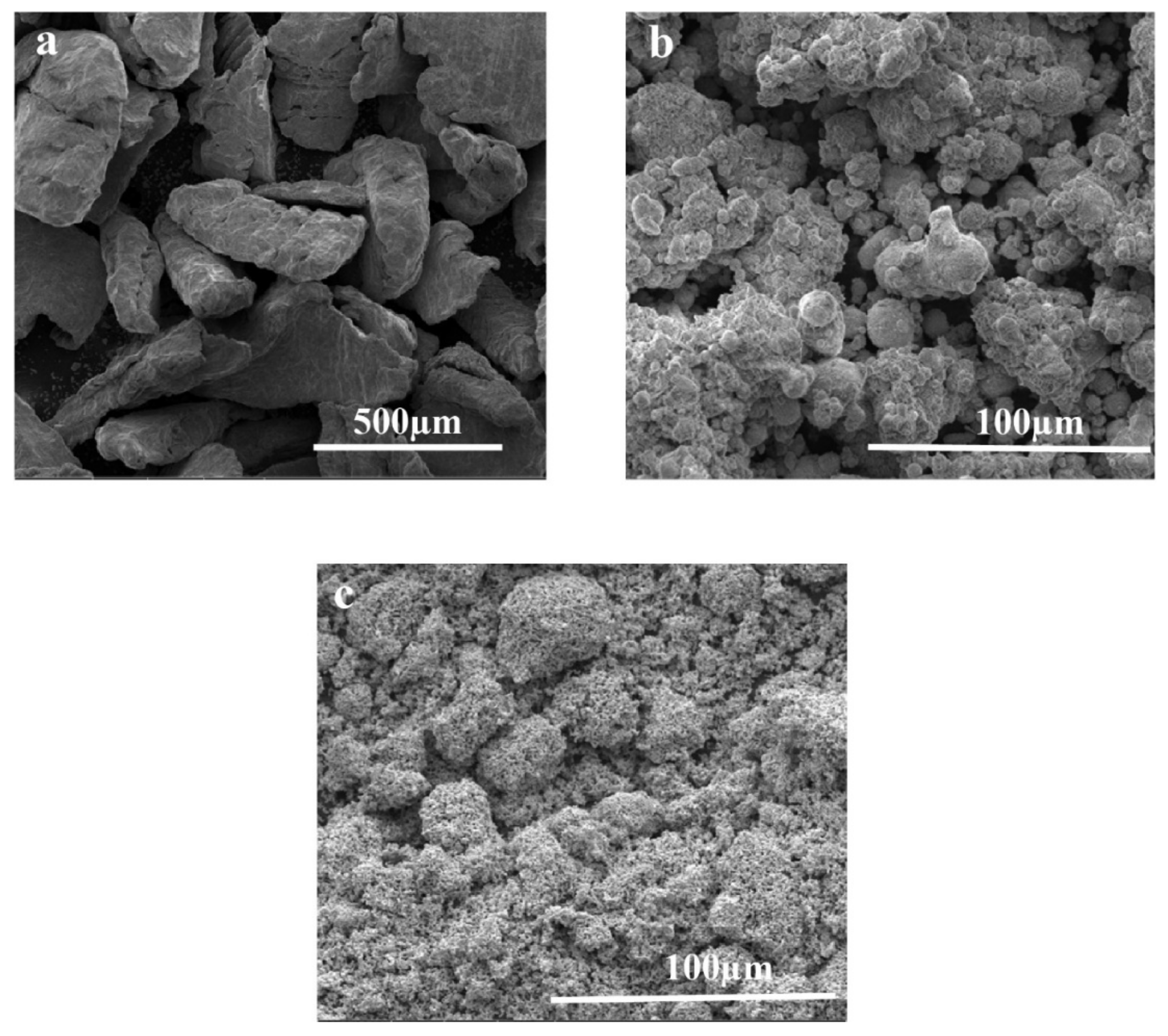
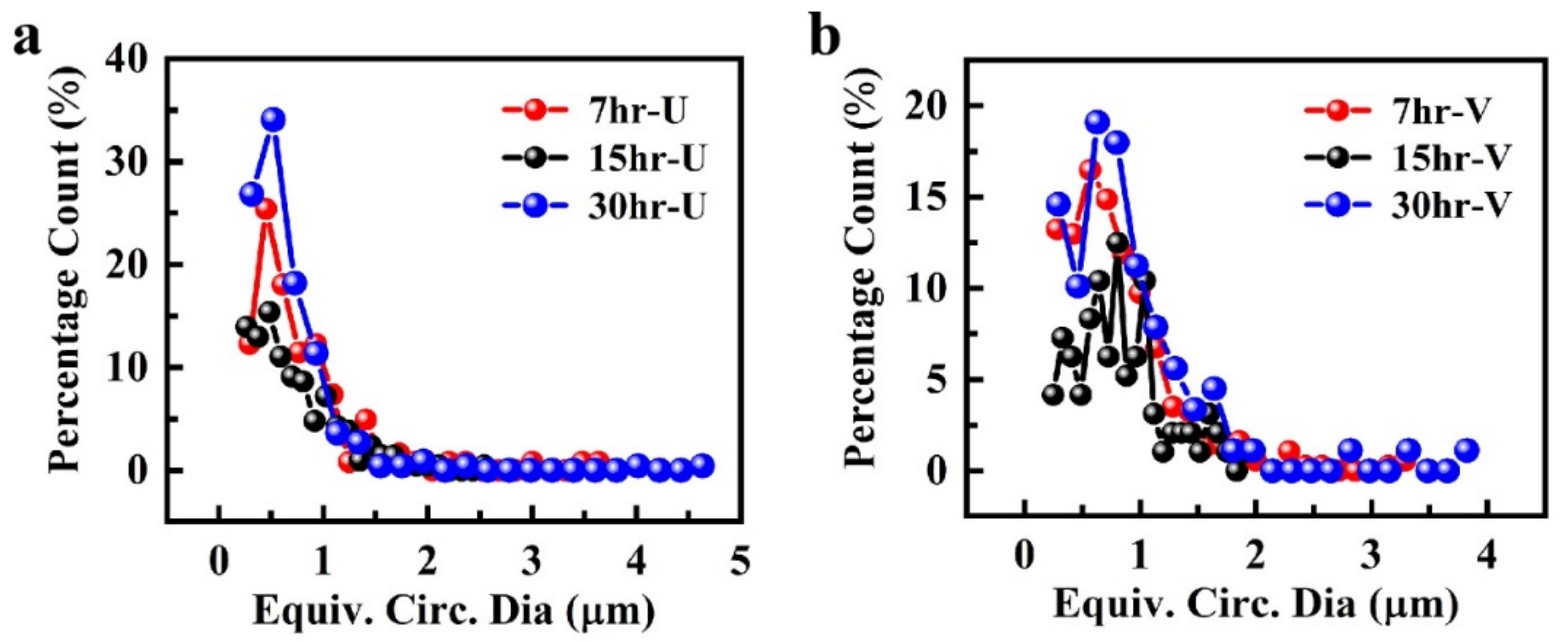

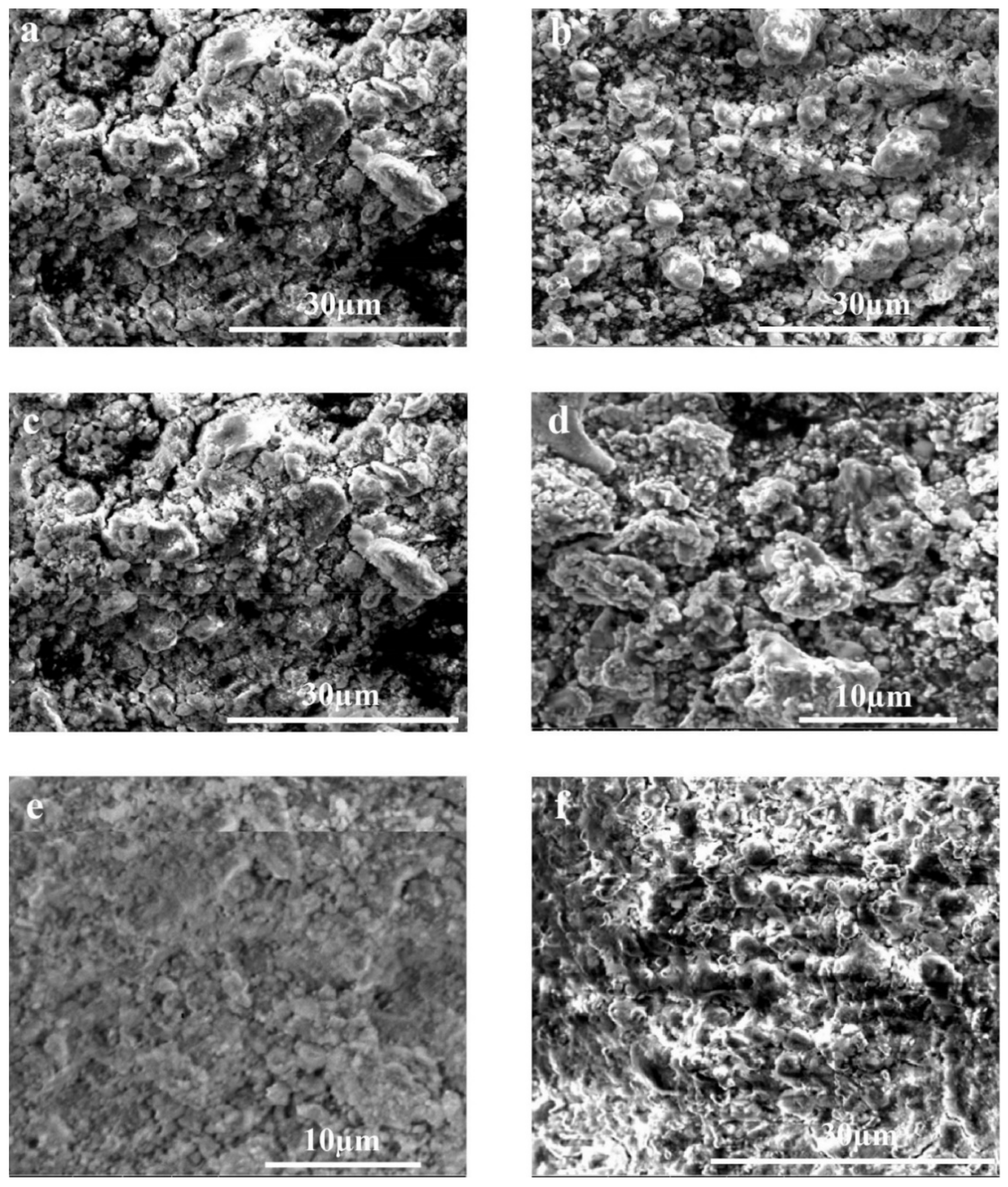
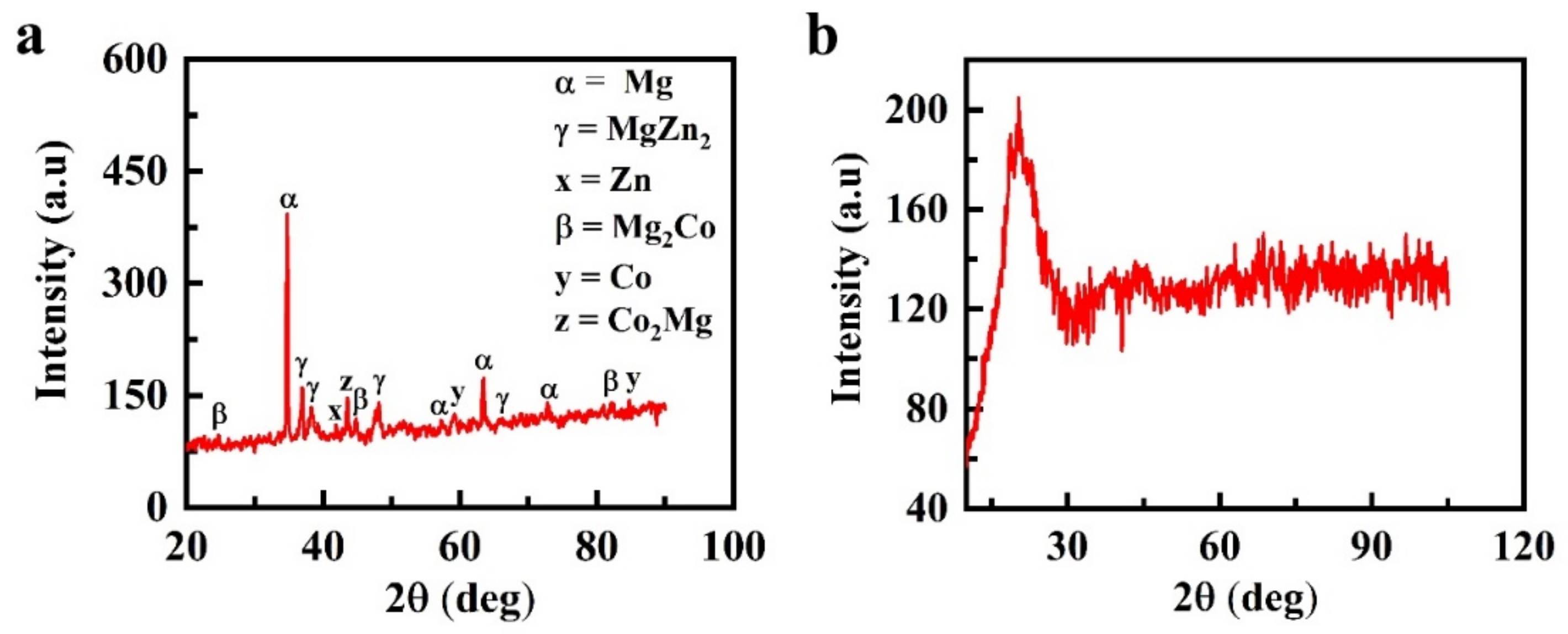
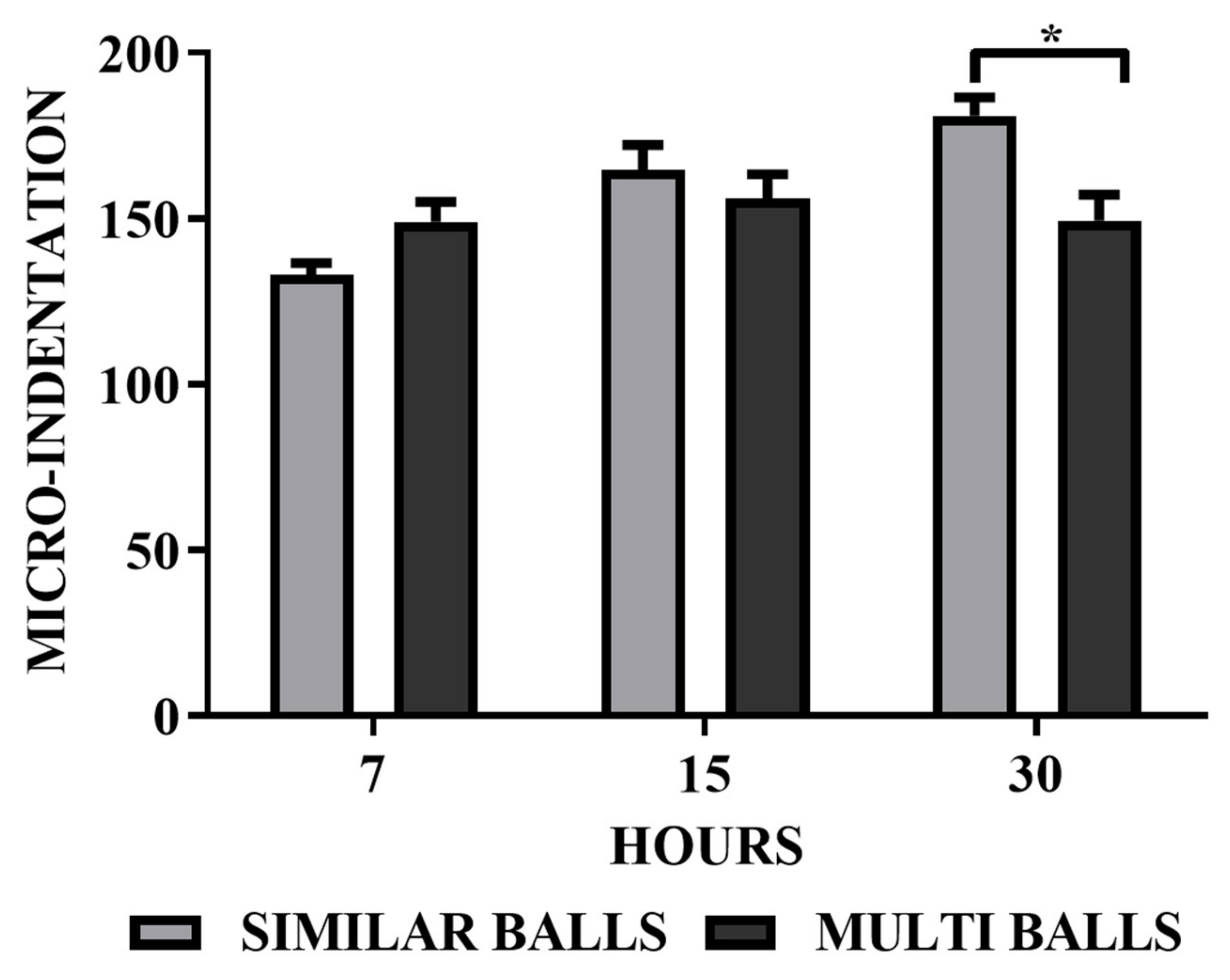
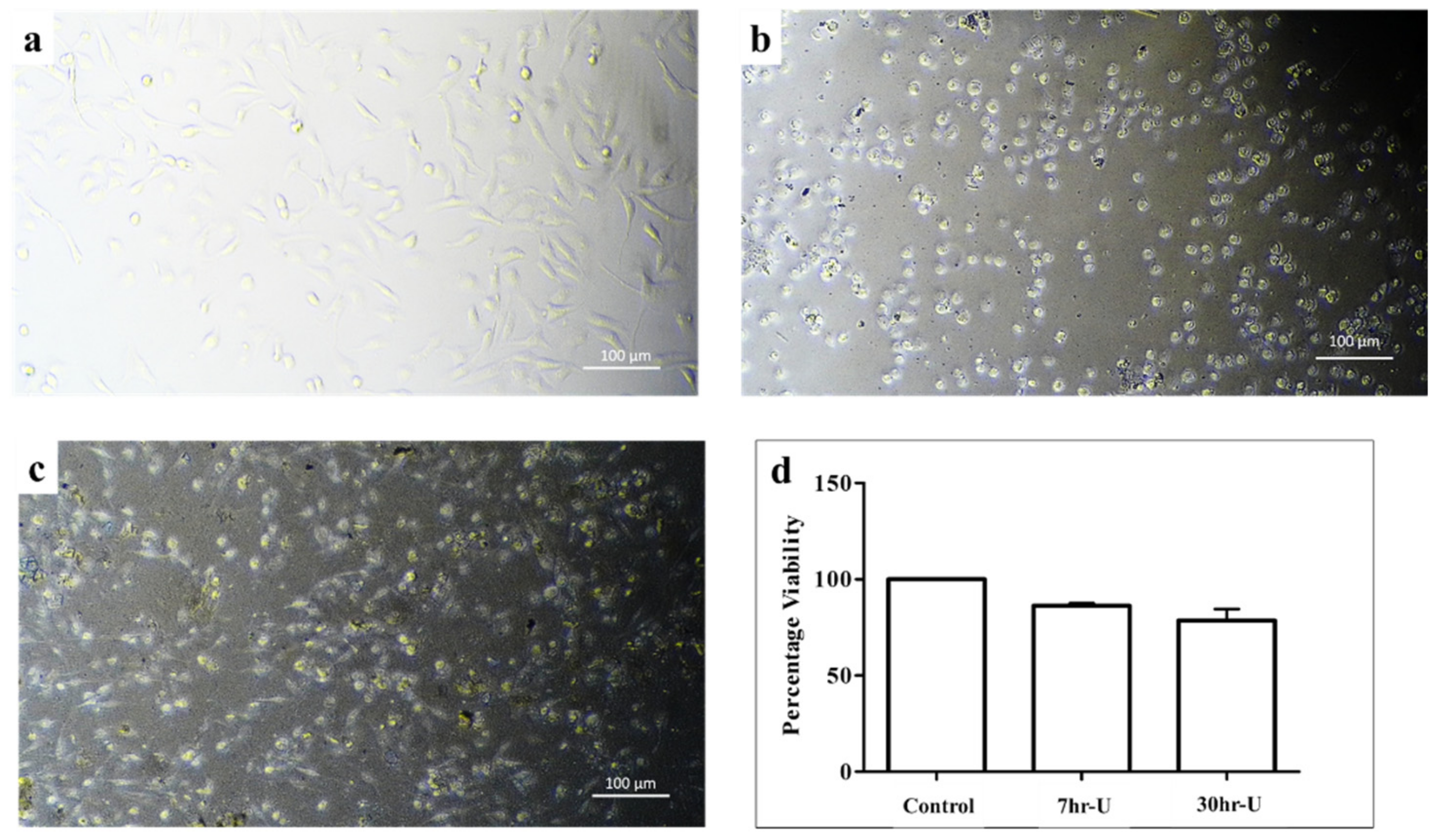
| Samples Xhr-U (h) | Percentage Count (%) | Particle Size (µm) |
|---|---|---|
| 7 | 70.5 | <1 |
| 15 | 75.5 | <1 |
| 30 | 85.86 | <1 |
| Samples Xhr-V (h) | ||
| 7 | 64 | <1 |
| 15 | 42 | <1 |
| 30 | 71.2 | <1 |
| Samples Xhr-U (h) | Atomic Percentage (%) | |||
|---|---|---|---|---|
| Mg | Zn | Co | O | |
| 7 | 62.18 | 20.28 | 16.81 | 0.82 |
| 15 | 60.14 | 21.22 | 18.01 | 0.90 |
| 30 | 50.31 | 24.3 | 24.91 | 0.30 |
| Samples Xhr-V (h) | ||||
| 7 | 57.52 | 29.62 | 10.63 | 2.23 |
| 15 | 62.18 | 16.82 | 20.71 | 0.53 |
| 30 | 51.59 | 20.85 | 26.73 | 0.38 |
Publisher’s Note: MDPI stays neutral with regard to jurisdictional claims in published maps and institutional affiliations. |
© 2022 by the authors. Licensee MDPI, Basel, Switzerland. This article is an open access article distributed under the terms and conditions of the Creative Commons Attribution (CC BY) license (https://creativecommons.org/licenses/by/4.0/).
Share and Cite
Mukhtar, S.; Kamran, M.; Ahmed, R.; Tayyeb, A. Effect of Milling Parameters on Mechanical Properties and In Vitro Biocompatibility of Mg-Zn-Co Ternary Alloy. Metals 2022, 12, 529. https://doi.org/10.3390/met12030529
Mukhtar S, Kamran M, Ahmed R, Tayyeb A. Effect of Milling Parameters on Mechanical Properties and In Vitro Biocompatibility of Mg-Zn-Co Ternary Alloy. Metals. 2022; 12(3):529. https://doi.org/10.3390/met12030529
Chicago/Turabian StyleMukhtar, Sehrish, Muhammad Kamran, Rafiq Ahmed, and Asima Tayyeb. 2022. "Effect of Milling Parameters on Mechanical Properties and In Vitro Biocompatibility of Mg-Zn-Co Ternary Alloy" Metals 12, no. 3: 529. https://doi.org/10.3390/met12030529
APA StyleMukhtar, S., Kamran, M., Ahmed, R., & Tayyeb, A. (2022). Effect of Milling Parameters on Mechanical Properties and In Vitro Biocompatibility of Mg-Zn-Co Ternary Alloy. Metals, 12(3), 529. https://doi.org/10.3390/met12030529






